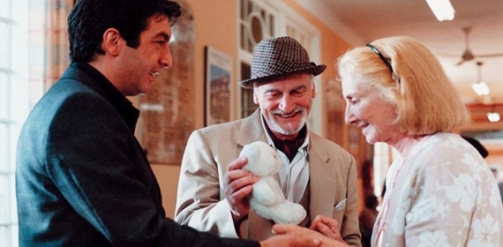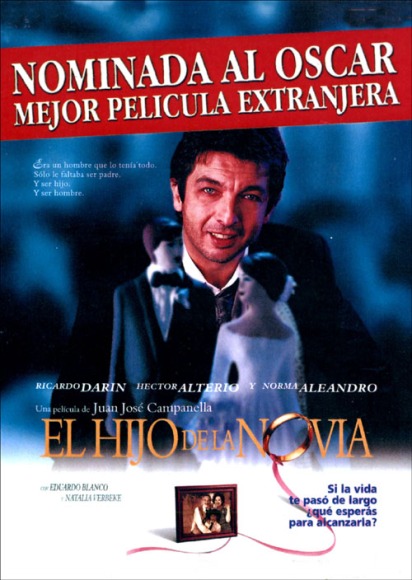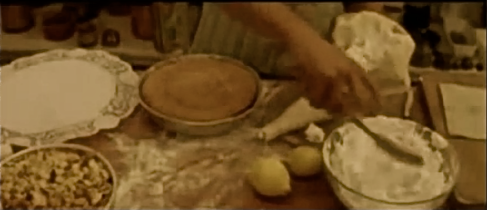The Son of the Bride and Tiramisu
(El hijo de la novia y Tiramisú)
I have a terribly sweet tooth and one of my favourite deserts is Tiramisu, of which I have a few humorous anecdotes to tell, but not here, unless of course you ask. Surprisingly, the 2001 Argentinean comedy-drama film, El hijo de la novia, The Son of the Bride, springs to mind, a cinematic masterpiece directed by Juan José Campanella [1]. But, why a desert of Italian origin should be discussed in a blog about Spanish language and culture, should come as no surprise, to those of you who follow my blogs. We will look at this later.

The Son of the Bride is a homage to the fragility of human dreams and pursuits. An ode to the ephemeral nature of life, which at times needs to be sweetened, as in the film, with a taste of Tiramisu.
The Hijo de la novia, brings together an exceptional cast of Argentinean actors and actresses and it is mainly two stories that run parallel paths. In the film, the Belvedere family reveal the loves of two different generations: Rafael played by Ricardo Darín and Naty, Rafael’s girlfriend (Natalia Verbeke); Nino, his father (Héctor Alterio) and his mother Norma (Norma Aleandro). The narrative of the film develops the idea of love confronting the vulnerability of life, its fragility and its endurance.
Nino is genuinely in love with Norma after 40 years together. He is burdened by the guilt that he did not fulfill, in his youth, Norma’s wish of marrying in a church and he wants to make amends. However, Norma suffers with Alzheimer’s, and is not aware of Nino’s scheme to put things right. Norma still appears to know those who she always loved. The remarkable performance of the actress, Norma Aleandro, gave me goosebumps and left me with a lump in my throat.

Norma Aleandro, Argentinean icon, film and television actress, who starred in many award winning films.
In the context of Argentina’s perennial economic woes, Rafael runs a restaurant and faces the struggle of a man’s midlife crisis, including his relationship with his girlfriend Naty. She feels excluded because he puts his own self limitations and selfishness before love. Will he find what is true and meaningful in his life?

Natalia Verbeke, Argentinean-Spanish film, theatre and television actress in her great performance as Naty, in The Son of the Bride.
This is a film that crosses the boundaries of love stories and explores the contradictions of the Catholic Church. When the priest refuses to marry his parents on the grounds of ill health, Rafael takes the opportunity to show the priest how detached the Church is from the real world. It is over these sequences of events that Rafael begins to discover what is essential in his life.

El hijo de la novia develops gently in so many layers, as with the layers of Tiramisu; and although during the film the whole recipe is not revealed, we are given a clue as to its key component: mascarpone cheese.
Hoy compramos mascarpone. El especial del día, Tiramisú Norma.
“Today we buy mascarpone. The daily special, Tiramisu Norma”; Rafael instructs Pacheco, the cook in his restaurant, making the point that a Tiramisu cannot be made with any cream cheese, even during the financial crisis that the whole country is going through.

In El hijo de la novia there are images and silent scenes that say more than a thousand words. There are also eloquent dialogues that stayed with me long after the film finished. I hope these dialogues will impact upon Spanish students and trigger a further debate (in Spanish of course).
Italian in origin, Tiramisu has become part of Latin American and particularly Argentinean Cuisine. In the absence of a Tiramisu recipe in the film, I would like to share the delicious Tiramisu recipe from my family, a super-dooper delicious one, from my beloved auntie and godmother Celia. The recipe will be available in my next blog.
¡Hasta la próxima!
 Footnotes
Footnotes
[1] A copy of the complete film El hijo de la novia in Spanish without subtitles can be found in YouTube, please click here.
A copy of a DVD of The son of the bride, with English subtitles, can be obtained from Amazon.es
… …
This article is part of the series: Recipes from the big screen. See Spanish and Latin American Cuisine (Part1) – Recetas de películas; and Recipes from the big screen. See Spanish and Latin American Cuisine (Part2) A Recipe for Almond Cake. Why is This Recipe so Special?
A Recipe for Almond Cake. Why is This Recipe so Special?
A delicious recipe from the film Sugar Times. Recipes from the big screen – Spanish and Latin American Cuisine (Part 2).
A tempting recipe for an Almond Cake is beautifully described at the beginning of the film Tiempos de azúcar, Sugar Times, a 2001 Spanish film directed by Juan Luís Iborra. Following a Spanish recipe is another opportunity to use the Spanish language in your everyday life; and why not learn Spanish whilst cooking?
The film begins with Miguel, a 7 year-old boy, writing in a book, nestled in the cosy setting of the family patisserie the “Horno de l’ Alteana“; his pregnant mother Isabel is tenderly dictating to him an old family recipe for an Almond Cake.
The scene captures the extraordinary poetry and tension of the moment. I asked myself: Is she worrying about the possible outcome of the pregnancy? Is this why she is choosing to impart the secret recipe to her son at that very moment, in the event she will not have the opportunity in the future?
She warns him to keep the recipe safe. “It is an old and very special recipe. My mother passed it to me before she died”. Further to this, she asks him for help in that way that mothers do when a choice is offered which is no choice. She states that when the baby comes, she will need his help in the patisserie, as they are on their own.

The curious little boy asks his mum in a quiet voice, “Why is this recipe so special?”
“Once upon a time”, she answers, “a Moorish bondmaid won the love of her Sultan, even though everybody thought her love was an impossible one. She created the recipe for this “Almond Cake” for the Sultan so lovingly; and the cake was so delicious, that in the end the Sultan made her his favorite wife [1].
This recipe is to be kept secret, Isabel warns again. Then, she starts to dictate to him the recipe:
“Se baten doce claras a punto de nieve. Cuando ya están bien duritas, se le echan las yemas. Luego se añade medio kilo de azúcar, (azúcar con la z, Miguel) poco a poco, sin dejar de batir, hasta que se deshaga. Luego se mezclan cien gramos de harina de almidón con cuatrocientos gramos de almendra molida. Se bate todo bien y se le echa la ralladura de un limón, y luego una hora de horno fuerte.
… …
“Beat twelve egg whites until stiff. When they are firm, add in the yolks and slowly pour in half a kilo of sugar (azúcar with z, Miguel), stirring constantly, until it dissolves. Then mix in one hundred grams of corn flour with four hundred grams of ground almonds. Beat all the ingredients well, with the zest of one lemon, and then put in a hot oven for an hour. [2]”

The two letter particle “se” could be of some concern to students learning Spanish, particularly when studying on their own. The particle “se” appears often in the Spanish language, and it has several meanings (himself, herself or itself) as well as different uses.
In this case, the use of “se” is known as “impersonal” and plays no syntactic function. The verb is in the third person and refers to a participant with ‘human’ and ‘undefine’ traits. [3]
Here there is a link to the first few minutes of the film (The recipe is given at 0.37 minutes, in Spanish): click here.

The complete film can be found on YouTube, only available in Spanish. An English subtitled version is available to buy on the internet. Set in Alicante, Spain, Tiempos de azúcar unpretentiously explores those simple things that make life worth living and raises the question: ¿Does life gives us a second opportunity? Juan Luis Borra has the great sensibility to capture significant vignettes throughout the film.

The magical opening of Tiempos de azúcar introduces us to the story of Miguel from childhood to youth and his two passions: his profession as a baker and the platonic love he feels for his lifetime good friend Angela, to whom he is unable to confess his love … until, that is, he decides to bake for her that legendary Almond Cake.
Now, I am not going to do as my naughty father used to do, when the family were watching a film that he had seen before, and he gave away the ending … What happens to Miguel and Angela? I am not going to tell you.
But … does life gives them a second chance?  Footnotes:
Footnotes:
[1] Free translation.
[2] Free translation.
[3] Se: It is a personal pronoun of the 3rd person, singular or plural, masculine and feminine (herself, himself and itself). It is used to construct impersonal sentences, eg.: se pelan las zanahorias, “peel the carrots”; amongst other uses.
This article is part of the series: Recipes from the big screen. See Spanish and Latin American Cuisine (Part1)

You must be logged in to post a comment.